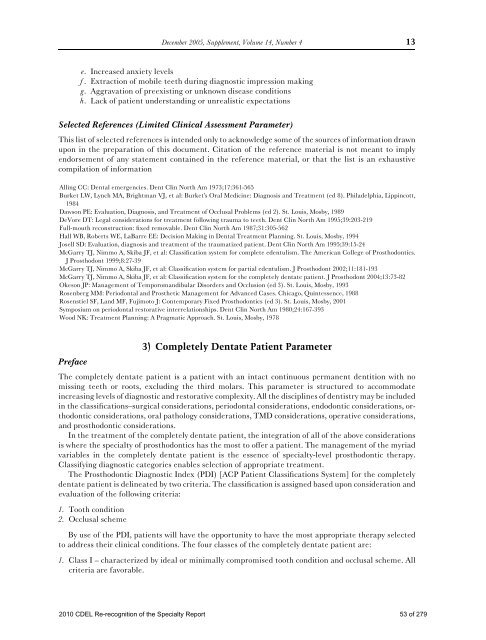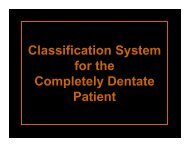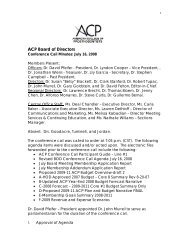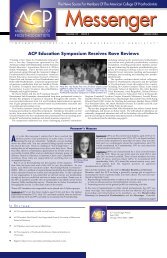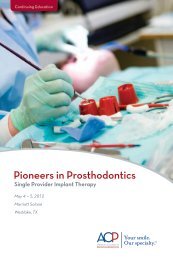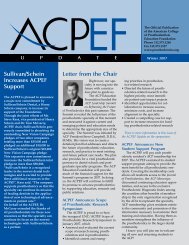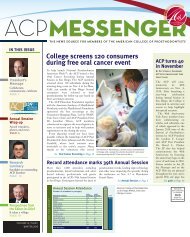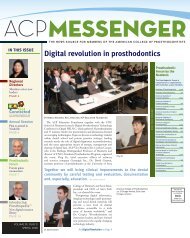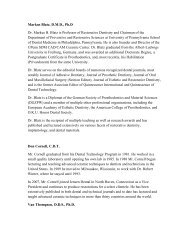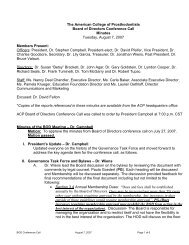PROSTHODONTICS - American College of Prosthodontists
PROSTHODONTICS - American College of Prosthodontists
PROSTHODONTICS - American College of Prosthodontists
You also want an ePaper? Increase the reach of your titles
YUMPU automatically turns print PDFs into web optimized ePapers that Google loves.
December 2005, Supplement, Volume 14, Number 4 13e. Increased anxiety levelsf . Extraction <strong>of</strong> mobile teeth during diagnostic impression makingg. Aggravation <strong>of</strong> preexisting or unknown disease conditionsh. Lack <strong>of</strong> patient understanding or unrealistic expectationsSelected References (Limited Clinical Assessment Parameter)This list <strong>of</strong> selected references is intended only to acknowledge some <strong>of</strong> the sources <strong>of</strong> information drawnupon in the preparation <strong>of</strong> this document. Citation <strong>of</strong> the reference material is not meant to implyendorsement <strong>of</strong> any statement contained in the reference material, or that the list is an exhaustivecompilation <strong>of</strong> informationAlling CC: Dental emergencies. Dent Clin North Am 1973;17:361-565Burket LW, Lynch MA, Brightman VJ, et al: Burket’s Oral Medicine: Diagnosis and Treatment (ed 8). Philadelphia, Lippincott,1984Dawson PE: Evaluation, Diagnosis, and Treatment <strong>of</strong> Occlusal Problems (ed 2). St. Louis, Mosby, 1989DeVore DT: Legal considerations for treatment following trauma to teeth. Dent Clin North Am 1995;39:203-219Full-mouth reconstruction: fixed removable. Dent Clin North Am 1987;31:305-562Hall WB, Roberts WE, LaBarre EE: Decision Making in Dental Treatment Planning. St. Louis, Mosby, 1994Josell SD: Evaluation, diagnosis and treatment <strong>of</strong> the traumatized patient. Dent Clin North Am 1995;39:15-24McGarry TJ, Nimmo A, Skiba JF, et al: Classification system for complete edentulism. The <strong>American</strong> <strong>College</strong> <strong>of</strong> Prosthodontics.J Prosthodont 1999;8:27-39McGarry TJ, Nimmo A, Skiba JF, et al: Classification system for partial edentulism. J Prosthodont 2002;11:181-193McGarry TJ, Nimmo A, Skiba JF, et al: Classification system for the completely dentate patient. J Prosthodont 2004;13:73-82Okeson JP: Management <strong>of</strong> Temporomandibular Disorders and Occlusion (ed 3). St. Louis, Mosby, 1993Rosenberg MM: Periodontal and Prosthetic Management for Advanced Cases. Chicago, Quintessence, 1988Rosenstiel SF, Land MF, Fujimoto J: Contemporary Fixed Prosthodontics (ed 3). St. Louis, Mosby, 2001Symposium on periodontal restorative interrelationships. Dent Clin North Am 1980;24:167-393Wood NK: Treatment Planning: A Pragmatic Approach. St. Louis, Mosby, 1978Preface3) Completely Dentate Patient ParameterThe completely dentate patient is a patient with an intact continuous permanent dentition with nomissing teeth or roots, excluding the third molars. This parameter is structured to accommodateincreasing levels <strong>of</strong> diagnostic and restorative complexity. All the disciplines <strong>of</strong> dentistry may be includedin the classifications–surgical considerations, periodontal considerations, endodontic considerations, orthodonticconsiderations, oral pathology considerations, TMD considerations, operative considerations,and prosthodontic considerations.In the treatment <strong>of</strong> the completely dentate patient, the integration <strong>of</strong> all <strong>of</strong> the above considerationsis where the specialty <strong>of</strong> prosthodontics has the most to <strong>of</strong>fer a patient. The management <strong>of</strong> the myriadvariables in the completely dentate patient is the essence <strong>of</strong> specialty-level prosthodontic therapy.Classifying diagnostic categories enables selection <strong>of</strong> appropriate treatment.The Prosthodontic Diagnostic Index (PDI) [ACP Patient Classifications System] for the completelydentate patient is delineated by two criteria. The classification is assigned based upon consideration andevaluation <strong>of</strong> the following criteria:1. Tooth condition2. Occlusal schemeBy use <strong>of</strong> the PDI, patients will have the opportunity to have the most appropriate therapy selectedto address their clinical conditions. The four classes <strong>of</strong> the completely dentate patient are:1. Class I – characterized by ideal or minimally compromised tooth condition and occlusal scheme. Allcriteria are favorable.2010 CDEL Re-recognition <strong>of</strong> the Specialty Report 53 <strong>of</strong> 279


